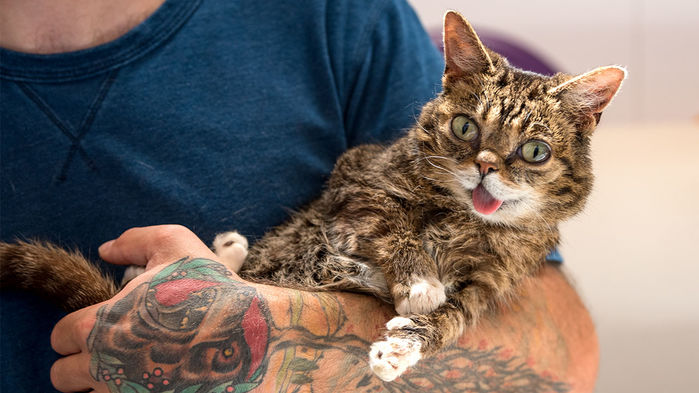
Cats may rule the internet, but few felines have achieved the online fame of Lil Bub. Discovered as a feral kitten outside Bloomington, Indiana, in 2011, she had a series of congenital abnormalities: extra toes, shorter-than-usual limbs, and a tongue that perpetually hangs out of her mouth. For owner Mike Bridavsky—and Lil Bub’s millions of internet fans—these peculiarities just made her more lovable.
For years, Lil Bub has been a spokescat for animal shelters, helping her furry brethren find homes of their own. Now, she’s helping scientists too. This week—thanks to a crowdfunding effort that raised more than $8000 on Experiment.com—geneticists led by Darío Lupiáñez of the Max-Delbrück Center for Molecular Medicine in Berlin; Daniel Ibrahim of the Max Planck Institute for Molecular Genetics in Berlin; and Orsolya Symmons of the University of Pennsylvania in Philadelphia—have sequenced Lil Bub’s whole genome.
The researchers discovered two tell-tale genetic abnormalities, they report on the preprint server bioRxiv. Lil Bub owes her extra toes to a somewhat common genetic variation in the Sonic hedgehog gene, also responsible for Ernest Hemingway’s famously polydactyl cats, whose six-toed progeny still roam his former home in Key West, Florida. The other key gene was more surprising: a variation of TNFRSF11A, a gene known from mice and humans to be associated with a rare condition called osteopetrosis, which causes unusually dense bones and short stature.
The preprint has already drawn amused attention from some scientists, with one tweeting, “Very jealous this wasn’t my Ph.D. project” and another writing, ” Comparative Genomics of Internet Cats is a Keystone Conference I look forward to attending.”
Science discussed the findings with Symmons and co-author Leslie Lyons, an expert on cat genetics at the University of Missouri in Columbia and founder of the 99 Lives Cat Genome Sequencing Initiative. The interview has been edited for clarity and length.
Q: Whose idea was this project?
O.S.: Darío and Daniel, the other two lead authors, were watching a documentary with Lil Bub, and they were like, “This is incredibly interesting. What might cause Bub to look like that? Do we know the genetics behind it?” So they had the scientific idea, but we knew it might be difficult to finance. Because I had a background in blogging, and because Bub is so popular, we thought we could try crowdfunding.
Orsolya Symmons
L.L.: For good or for bad, celebrities attract attention, whether it’s human celebrities or animal celebrities. We’ve tried to get other celebrity cats to jump on board before, but Lil Bub was the bravest of them all.
Q: How did you get Lil Bub’s owners involved?
O.S.: Daniel and Dario reached out to Mike, the owner of Bub, and he’s incredibly open and super excited about everything Bub-related. He’s not a scientist, so throughout the whole process we were keeping in touch and breaking everything down for him about what we were finding and why it was interesting.
Q: Were you surprised by the findings?
L.L.: At first, you’re thinking Lil Bub’s polydactyly and her limb shortness are all part of the same syndrome. Then you start to tease it apart and you realize, no, she has Sonic hedgehog mutations that have nothing to do with the osteoporosis issue that’s going on. It was like, “Wow, that’s kind of weird, the cat has two different rare mutations.”
Q: Why is this discovery important?
O.S.: Nobody had ever described this type of genetic osteopetrosis in cats, but there are very similar mutations in the same gene in mice and in humans that also cause osteopetrosis.
Leslie Lyons
L.L.: Humans have this disease, too, and knowing more about how this mutation functions might help lead to a tailored therapy with precision medicine that affects the gene.
It also shows why animal genetics is important. In human genetics, there’s a still a huge number of variants of unknown significance, which basically means you don’t know if they’re benign or not. That’s one of the things our project is trying to do. If you look at the genetic information in cats and dogs, that might tell you a particular mutation is found all the time in cats and they’re perfectly fine, so it probably is a benign mutation.
Q: What’s next for your work?
O.S.: When you mention you have a crowd-funded celebrity cat project, people don’t necessarily take the science seriously, but it is a serious scientific project. It would be great to get it published. That’s partially why we put it out on bioRxiv, to get some peer feedback in case we missed anything really obvious.
Also, because we’ve put it out in the public domain, we’re hoping that anyone who’s interested in it can do what they want and see where they can take this. We’ve seen a lot of tweets so far from teachers who say they plan to use this in their classrooms. We’re kind of hoping this takes on a life of its own.
L.L.: I hope this shows the importance of funding cat research. Here’s something that was hard to get funded—that they had to go beg the crowd to get funding for—and it comes up with a very important biological consequence. In the end, it’s not a gimmick. It’s how we’ve had to struggle in the cat world to do good science.
